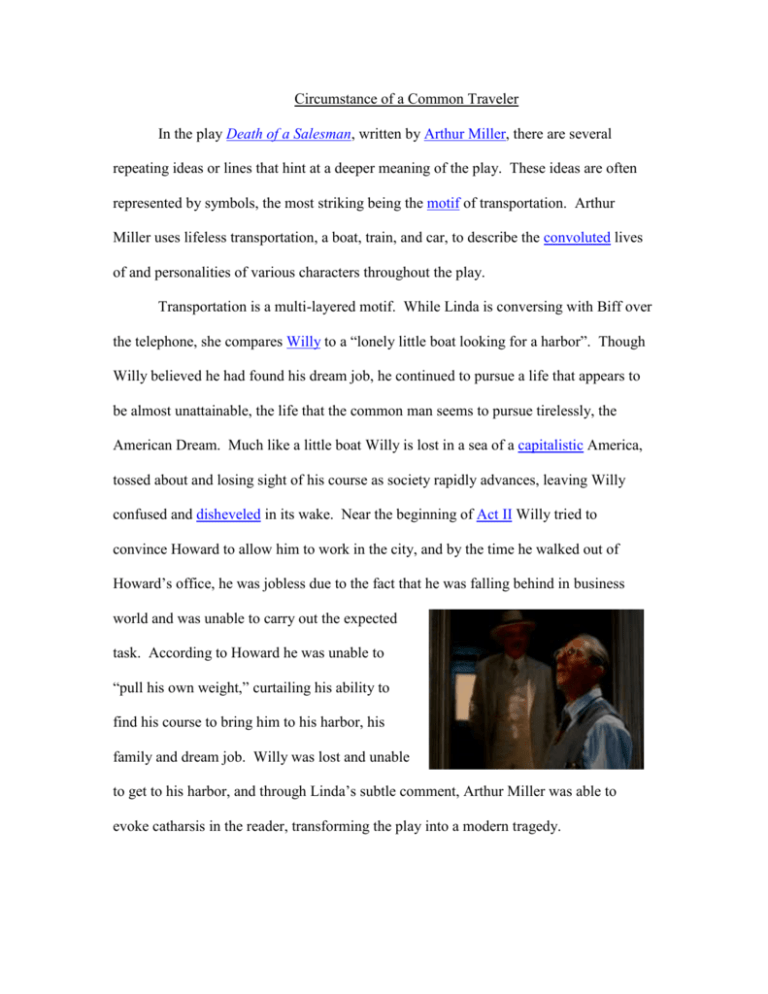In the play Death of a Salesman, written by Arthur Miller, there are
advertisement

Circumstance of a Common Traveler In the play Death of a Salesman, written by Arthur Miller, there are several repeating ideas or lines that hint at a deeper meaning of the play. These ideas are often represented by symbols, the most striking being the motif of transportation. Arthur Miller uses lifeless transportation, a boat, train, and car, to describe the convoluted lives of and personalities of various characters throughout the play. Transportation is a multi-layered motif. While Linda is conversing with Biff over the telephone, she compares Willy to a “lonely little boat looking for a harbor”. Though Willy believed he had found his dream job, he continued to pursue a life that appears to be almost unattainable, the life that the common man seems to pursue tirelessly, the American Dream. Much like a little boat Willy is lost in a sea of a capitalistic America, tossed about and losing sight of his course as society rapidly advances, leaving Willy confused and disheveled in its wake. Near the beginning of Act II Willy tried to convince Howard to allow him to work in the city, and by the time he walked out of Howard’s office, he was jobless due to the fact that he was falling behind in business world and was unable to carry out the expected task. According to Howard he was unable to “pull his own weight,” curtailing his ability to find his course to bring him to his harbor, his family and dream job. Willy was lost and unable to get to his harbor, and through Linda’s subtle comment, Arthur Miller was able to evoke catharsis in the reader, transforming the play into a modern tragedy. Willy’s tragedy progresses through Arthur Miller’s use of motifs. The train that was carrying Willy’s brother, Ben, away in and out of his recollections, carried Ben to success and wealth, whereas Willy was simply a common man who tried in vain to attain the American Dream. Every time Ben was about to leave in Willy’s flash backs, he invited Willy to join him on his adventure to achievement, but every time, Willy turned him down composedly, believing that his life was much better than anything or anywhere that the train could take him to. This train was Willy’s missed opportunity. Each time Willy ignored Ben’s invitation, he missed an opportunity that he often regretted passing up. This single motif and its underlying meaning evokes sympathy in the reader because they can relate to Willy’s unfortunate situation, but there is also an aura of fear due to the reality of Willy’s situation, that this simple man missed a moment of opportunity, and by doing so, had to live with the unmet expectations that he had for himself. Because of the fact that Willy was unable to experience the American Dream, he drove himself to a severely unstable mental state where in his mind, everything is perfect and he is a huge success and of great importance. This near insanity is so cleverly reflected in the red Chevrolet that is mentioned so often throughout the play. In Act I, Willy mentions how the “Chevrolet…is the greatest car ever built.” Willy’s view of his car is very similar to his usual view of himself, strong, flourishing, and very popular and well liked. Unfortunately, a short time after his remark of about the car, Willy changes his mind, saying “that goddamn Chevrolet, they ought to prohibit the manufacture of that car!” The harsh attitude shown in this scene is very similar to Willy’s attitude when he is confronted by reality and has to acknowledge and accept the fact that he is not the same man as Dave Singleman, a very successful salesman. Throughout the play, the car was continually breaking down, very similar to Willy’s deteriorating mental state, continuously convincing him to believe that he was who he wanted to be, and needs to do what he wants to, even though previous efforts to accomplish these feats resulted in failure. Willy’s car is a symbol that Willy uses to show his material wealth, hoping that this will result in him being favored in the eyes of everyone else. Lastly his car is used as a tool in his suicide; the annihilation of his car is also the ending to Willy’s life as well and as the car would have been regarded and remember by very few, the same occurred with Willy; the number of guest attending his funeral remained in the single digits. Instead of the funeral being Willy’s final triumph, it was his final humiliation. Through the use of specifically chosen motifs, Death of a Salesman relates certain means of transportation to the protagonist, Willy Loman. Arthur Miller uses this last event to skillfully end this modern day tragedy of a common man. Analysis of Major Characters. N.p., n.d. Web. 5 June 2012. <http://www.sparknotes.com/lit/salesman/canalysis.html>. American Dream. N.p., n.d. Web. 5 June 2012. <http://en.wikipedia.org/wiki/American_dream>. Arthur Miller. N.p., n.d. Web. 5 June 2012. <http://en.wikipedia.org/wiki/Arthur_Miller>. aura. N.p., n.d. Web. 5 June 2012. <http://dictionary.reference.com/browse/aura?s=t>. capitalism. N.p., n.d. Web. 5 June 2012. <http://dictionary.reference.com/browse/capitalism>. convoluted. N.p., n.d. Web. 5 June 2012. <http://dictionary.reference.com/browse/convoluted>. Death of a Salesman: Act I. N.p., n.d. Web. 5 June 2012. <http://www.litcharts.com/lit/deathofasalesman/act1>. Death of a Salesman: Act II. N.p., n.d. Web. 5 June 2012. <http://www.litcharts.com/lit/deathofasalesman/act2>. Death of a Salesman Trailer. N.p., n.d. Web. 5 June 2012. <http://www.youtube.com/watch?v=GM5_oxoux8Q>. disheveled. N.p., n.d. Web. 5 June 2012. <http://dictionary.reference.com/browse/disheveled>. motif. N.p., n.d. Web. 5 June 2012. <http://dictionary.reference.com/browse/motif>. <http://www.bbc.co.uk/learningzone/clips/images/previews/s_engl/s_engl_ec_02638_16x9.jpg>. N.p., n.d. Web. 5 June 2012. <http://pics.imcdb.org/0is367/coupchevrolet2toiles3ml.7641.jpg>. N.p., n.d. Web. 5 June 2012. <http://pics.imcdb.org/0is402/11death8.2694.jpg>. N.p., n.d. Web. 5 June 2012. <http://chrislynch.canalblog.com/images/animation_mort_lourde.gif>. N.p., n.d. Web. 5 June 2012. <http://ferdyonfilms.com/Death%201.jpg>. N.p., n.d. Web. 5 June 2012. <http://3.bp.blogspot.com/fj0pshrVpQ0/Twxvgv96q8I/AAAAAAAAWw8/kjMzQQe8jVs/s1600/hoffman.png>. N.p., n.d. Web. 5 June 2012. <http://ferdyonfilms.com/Death%2010.jpg>.





